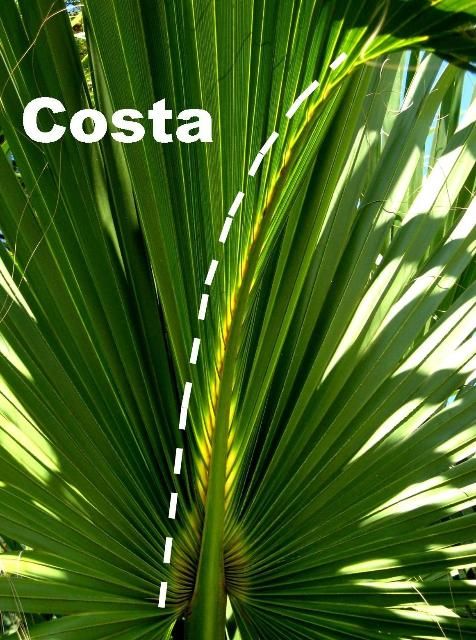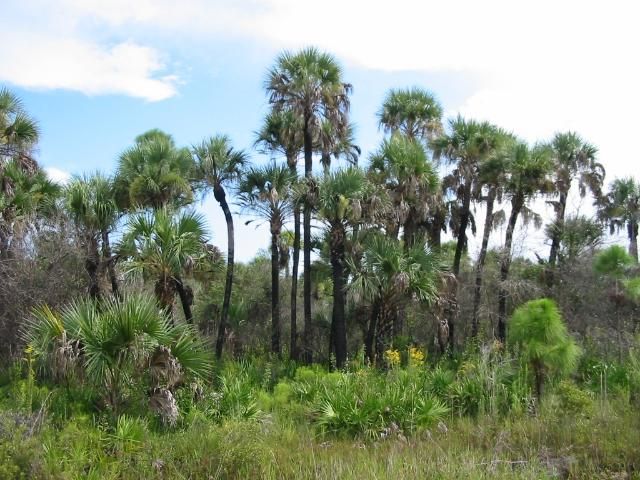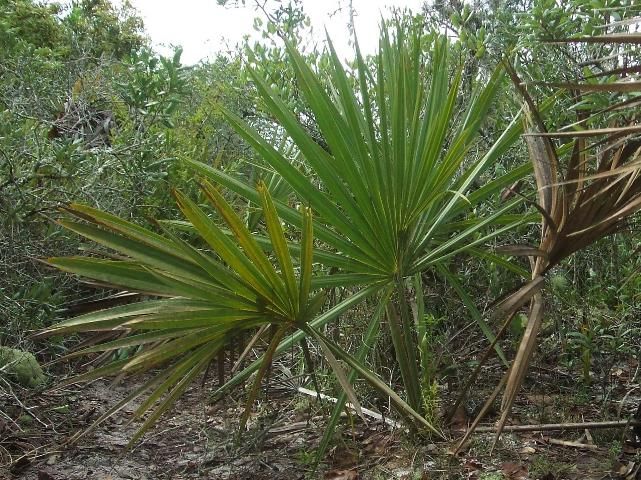Sabal palmetto is the state tree of both Florida and South Carolina where it is commonly known, respectively, as "cabbage palmetto" and as the "palmetto tree." S. palmetto is the most widespread arborescent palm (having an aboveground trunk) native to the United States. It is one of sixteen species of Sabal, four of which occur naturally in Florida.
This fact sheet will help field investigators identify the four Sabal species found in Florida's natural areas, first by distinguishing them from other fan palms and then from each other. Table 1 summarizes key identification attributes. In the planted landscape, a more detailed key will be necessary for palm identification as only Sabal species native to Florida are addressed here.
First, what is a palmetto?
While traveling through the Florida peninsula, a casual observer will notice a wide variety of palms and find that many are called "palmetto." When referring to plants, the use of common names can be problematic. Scientists prefer the Latin binomial or "scientific name" when speaking of a particular plant. However, various natural history, ethno-botanical, and folk literature accounts simply mention "palmetto," thus causing some confusion as to which palm is being described. Spanish conquistadores who landed on Florida's northeast coast immediately noticed the "palmito" or little palms growing everywhere. The "palmetto" moniker has since been applied in common names to the following Florida palm species in two different genera:
- Serenoa repens = saw palmetto or simply "palmetto," the most frequent modern application of the name
- Sabal palmetto = cabbage palmetto or palmetto tree
- Sabal etonia = scrub palmetto, bush palmetto
- Sabal minor = swamp palmetto, dwarf palmetto
- Sabal miamiensis = Miami palmetto (rare or extinct)
Genus Sabal
Before modern genetic techniques, identifying and classifying palms worldwide was a messy business. Taxonomists would rename and juggle taxa among groups when new species were identified based on morphological characteristics or geography. The recognition and description of the genus Sabal by French botanist Michel Adanson in 1763 led to later reclassification of taxa previously placed in Old World genera.
Sabal species, part of the New World Thatch Palm group, have dispersed over long distances and are adapted to a wide range of conditions around the Gulf of Mexico and Caribbean basin. Ecologically, Florida Sabal species occupy many distinct ecosystems, which likely explains their differentiation. Therefore, geography is an important piece of the Sabal identification puzzle in Florida.
Sabal palms can be separated from all other genera of fan palms by three key characteristics:
- costapalmate fronds or leaves,
- unarmed petioles (smooth, no thorns or spines anywhere on the palm), and
- split leaf bases where fronds attach to the stem.
Figure 1 shows the costa as a long, narrow, triangular extension of the petiole that divides the leaf, sometimes adding a folded effect, hence the term "costapalmate" fronds. Saw palmetto (Serenoa repens) has a palmate frond with no costa, thus distinguishing it from Sabal palms.

Credit: David A. Fox, UF/IFAS
Sabal Species in Florida
Sabal palmetto (Walt.) Lodd. ex J.A. & J.H. Schultes, cabbage palm is arborescent or tree-like with a stout trunk between 6 inches (15 cm) and 18 inches (45 cm) in diameter, with or without old leaf bases attached (Figure 2). Cabbage palms can remain in an "establishment" or "juvenile" phase for many years before developing an aboveground trunk. During this trunkless stage they will not flower or fruit. Therefore, a trunkless Sabal-like palm with an inflorescence cannot be S. palmetto. The 15–30 leaves with prominent costa have long thin filamentous fibers between leaf segments. The arching inflorescences are longer than the leaves and occur within the canopy between leaves. Fruit are usually less than 1 cm diameter. Cabbage palms are found in hydric, mesic, flatwoods, lower sandhill, and coastal forest ecosystems. They can live behind the first dune and are tolerant of salt spray. In northern Florida, S. palmetto typically grows as scattered understory plants within temperate mesic hammocks or on mounds in floodplain swamps where they are easily confused with S. minor on wetter sites. Cabbage palms can be a dominant canopy tree along creeks or in coastal forests. In southern Florida, cabbage palms form nearly monotypic hammocks in wet flatwoods or cypress/pine savannas.

Credit: David A. Fox, UF/IFAS
Sabal etonia Swingle ex Nash., scrub palmetto, bush palmetto, bluestem, or corkscrew palmetto has a solitary underground (rarely aboveground to 1 meter) spiral-shaped trunk and 4–7 yellow-green leaves with a prominent costa and filaments between leaf segments (Figure 3). As the common name implies, scrub palmetto is found only in dry pinelands and sand pine scrub along the central Florida ridge and some of the coastal ridges of southeast Florida. Inflorescences are usually shorter than the leaves, and fruit range from 1–1.5 cm in diameter. The somewhat similar saw palmetto (Serenoa repens) has short, saw-like thorns along either side of the petiole in contrast to the characteristic smooth petiole of Sabal, and S. repens has palmate fronds rather than the costapalmate leaves of Sabal.

Sabal minor (Jacq.) Pers. dwarf palmetto or swamp palmetto has a solitary subterranean stem (rarely above-ground to 2 m) and 4–10 dark green leaves with a weak costa (Figure 4). Leaf segments are only joined a short distance near the base and have no filamentous fibers. Inflorescences are branched twice and extend beyond the leaves. S. minor is found on moist to wet alluvial soils from north central Florida to the Carolinas and west to Texas, typically as an understory species in temperate deciduous hardwood forests. The needle palm (Rhapidophyllum hystrix) grows in similar habitat but is distinguished by the long needles emanating from the leaf sheaths near the bud.

Credit: David A. Fox, UF/IFAS
Sabal miamiensis Zona Miami palmetto (rare or extinct) is a solitary palm with an underground stem and 3–6 strongly costapalmate leaves, said to curve to a near circle. Filamentous fibers between leaf segments may or may not be present. The inflorescence is branched 3 times (distinguishing it from S. etonia, which is branched twice) with rather large fruit 1.5 to 2 cm in diameter. This palm is only found in the Miami-Dade rock pinelands of southeast Florida on shallow calcareous soils and limestone outcroppings. Because of the intensive urban development of that region, some authors believe this species to be nearly extinct.
References
Dransfield, John, Natalie W. Uhl, and Royal Botanic Gardens Kew. Genera Palmarum: The Evolution and Classification of Palms. Richmond, Surrey, UK: Kew Pub., 2008.
Henderson, Andrew, Gloria Galeano, and Rodrigo Bernal. Field Guide to the Palms of the Americas. Princeton, N.J.: Princeton University Press, 1995.
Riffle, Robert Lee, and Paul Craft. An Encyclopedia of Cultivated Palms. Portland, Or.: Timber Press, 2003.
Wunderlin, Richard P. Guide to the Vascular Plants of Central Florida. Gainesville, FL: University Press of Florida, 1982.
Zona, Scott. "A Monograph of Sabal Arecaceae Coryphoideae." Aliso 12, no. 4 (1990): 583–666.
———. "A Taxonomic Study of the Sabal Palmetto Complex (Palmae) in Florida." Thesis (MS), University of Florida, 1983.